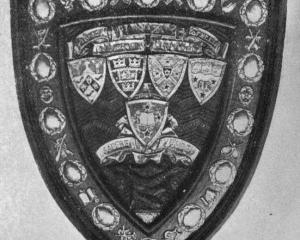Some few years ago the project was mooted of celebrating a period of 50 years' work by replacing the wooden structure of the early days with a more modern building. There were numerous delays - in fact, these appear inevitable in the matter of church building.
Wet seasons and not too bountiful harvests retarded the collectors; but about 12 months ago an earnest move was made, and a canvass of the congregation resulted in sufficient support being forthcoming to warrant the Church Building Committee in accepting the most desirable tender for a brick building - that of Mr A. A. Aburn, of Dunedin - at about 1800.
Mr Edmund Anscombe, of Dunedin, furnished the plans, and was appointed architect. There were many meetings of the Building Committee, and much discussion occurred over the disposal of the old building and placing the new one on the same site, which is really the most desirable one.
But there was opposition to sacrificing the old building - doubtless much of it on the sentimental side; but those who wished to do nothing that would create disruption or hinder the progress of the new church, readily gave way; and finally it was decided to place the new beside the old, but bringing the former closer to the street line.
The contractor made rapid progress with the work, and there now stands a building that is a credit to the congregation and the district alike.
• ''In the interests of humanity, as well as of national wealth, a bold, vigorous, and progressive national roading policy is called for,'' says Bishop Cleary, after a motoring tour of the Far North.
The tracks of the north are described by his Lordship as being of a generally atrocious character. Speaking of the steady increase of intelligent and highly desirable settlers in the mountainous districts to the north west of the Hokianga River, Bishop Cleary says that in the matter of communication a great number of them are enduring conditions of utter barbarism.
Dr Cleary urges that while the land should be settled fast and well, roading should precede settlement, and not follow it, and it should go hand in hand with the extension of settlement as a great national concern.
• An event not recorded by the press generally was the recent visit of a German submarine, U17, to Bergen, the chief port of Norway. From an account given in a letter from Norway, it appears that the submarine suddenly popped up outside the reefs which guard the entrance to the port of Bergen, and hailed a couple of men who were fishing close by.
These men were ordered to pilot the submarine into the harbour to effect certain repairs. They did so, and, when the dangerous reefs were passed, they were told they could go.
They went as quickly as they could, and informed the authorities, and a Norwegian torpedo boat went out to look for the submarine, which was apparently trying to find its own way in. The submarine was discovered, and its captain stated that he wanted to effect repairs.
He was told that if he wanted to do so he must come right inside, and lay up alongside the wharf. This he refused to do, no doubt being anxious that his boat might escape inspection.
The commander of the Norwegian torpedo boat then ordered the intruder to clear out quick and lively on pain of being sunk. Deeming discretion the better part of valour, the German turned about, and went to sea again, personally conducted by the torpedo boat, until well beyond the three mile limit.
- ODT 23.2.1915.












